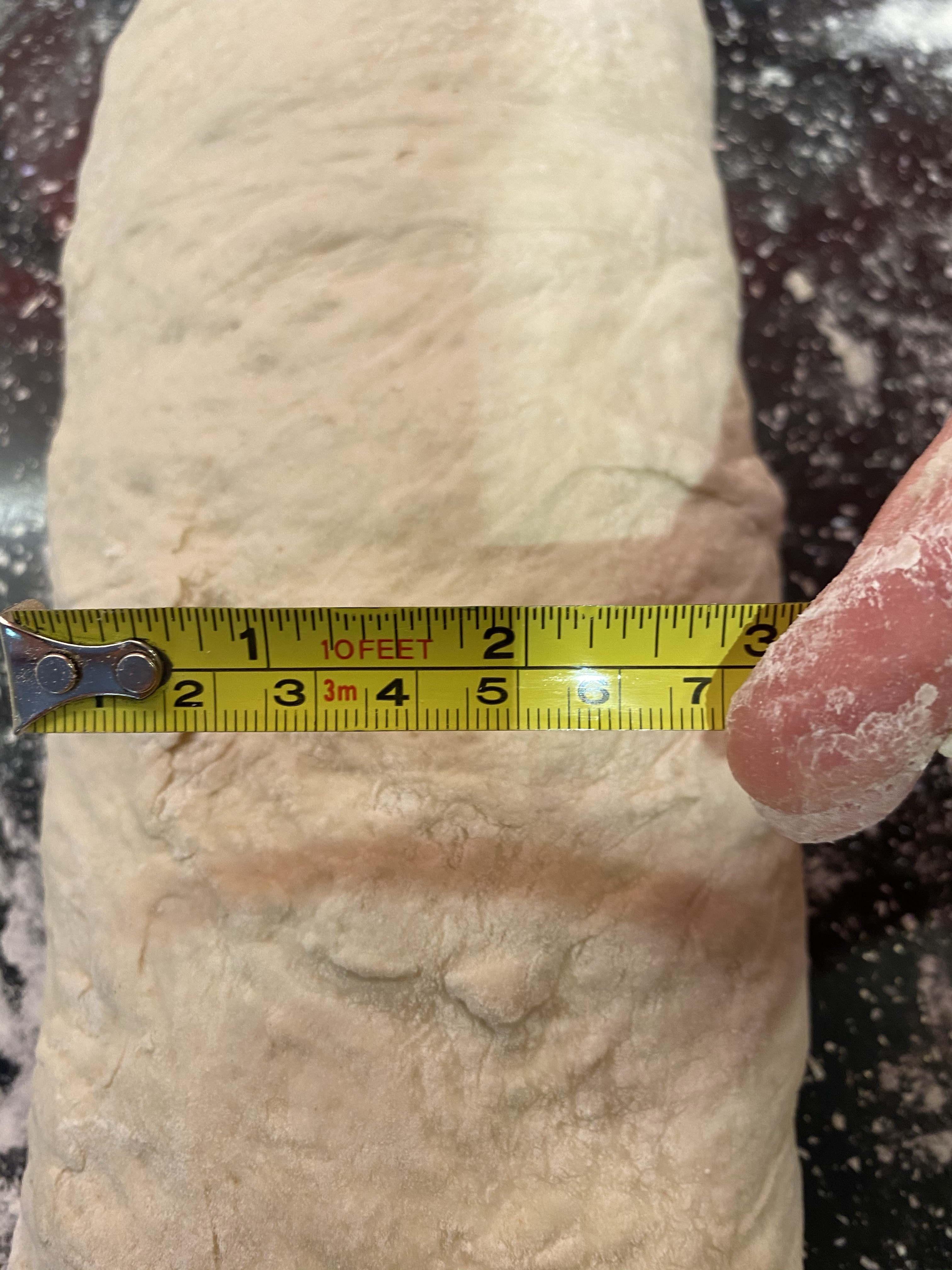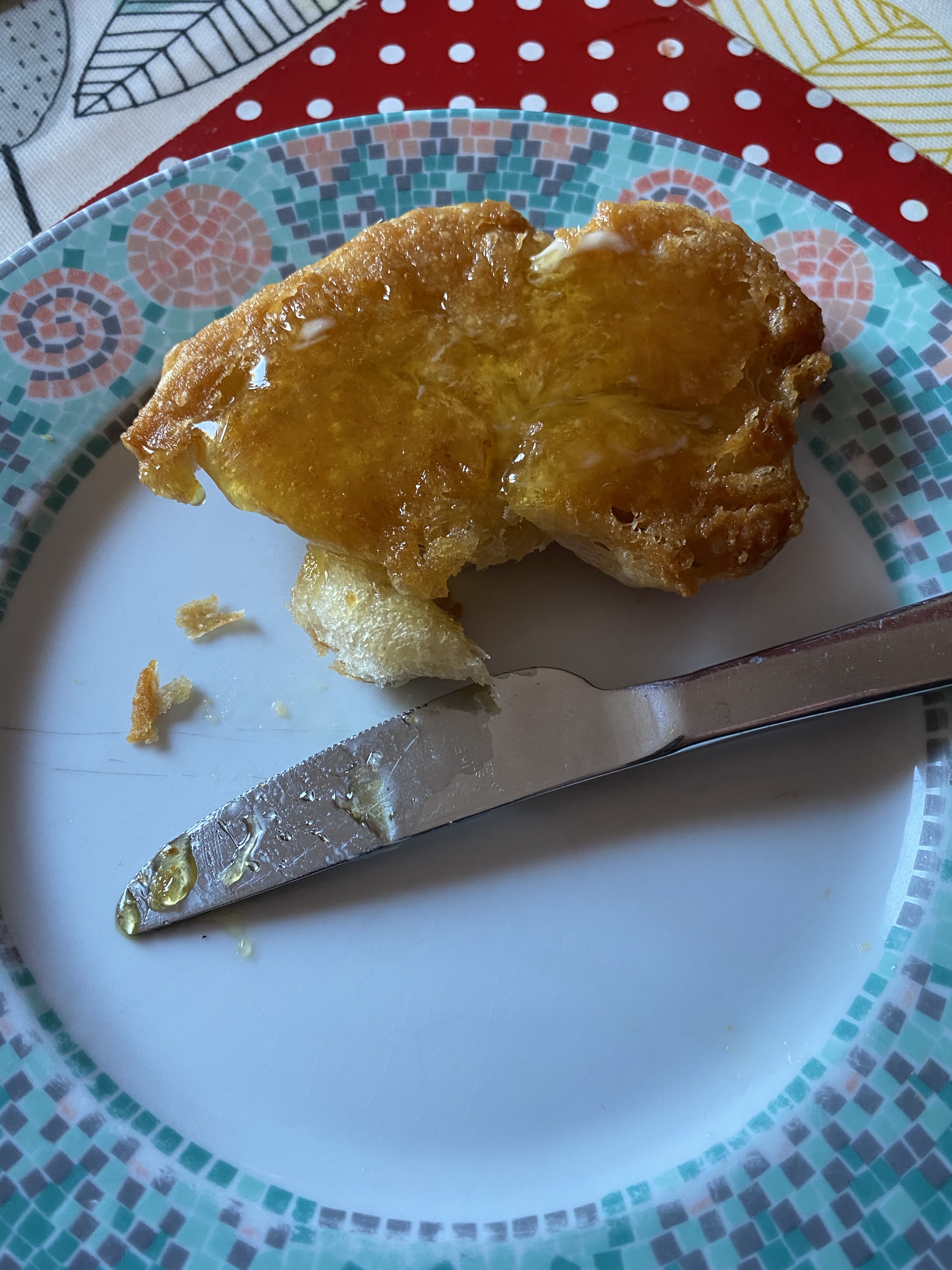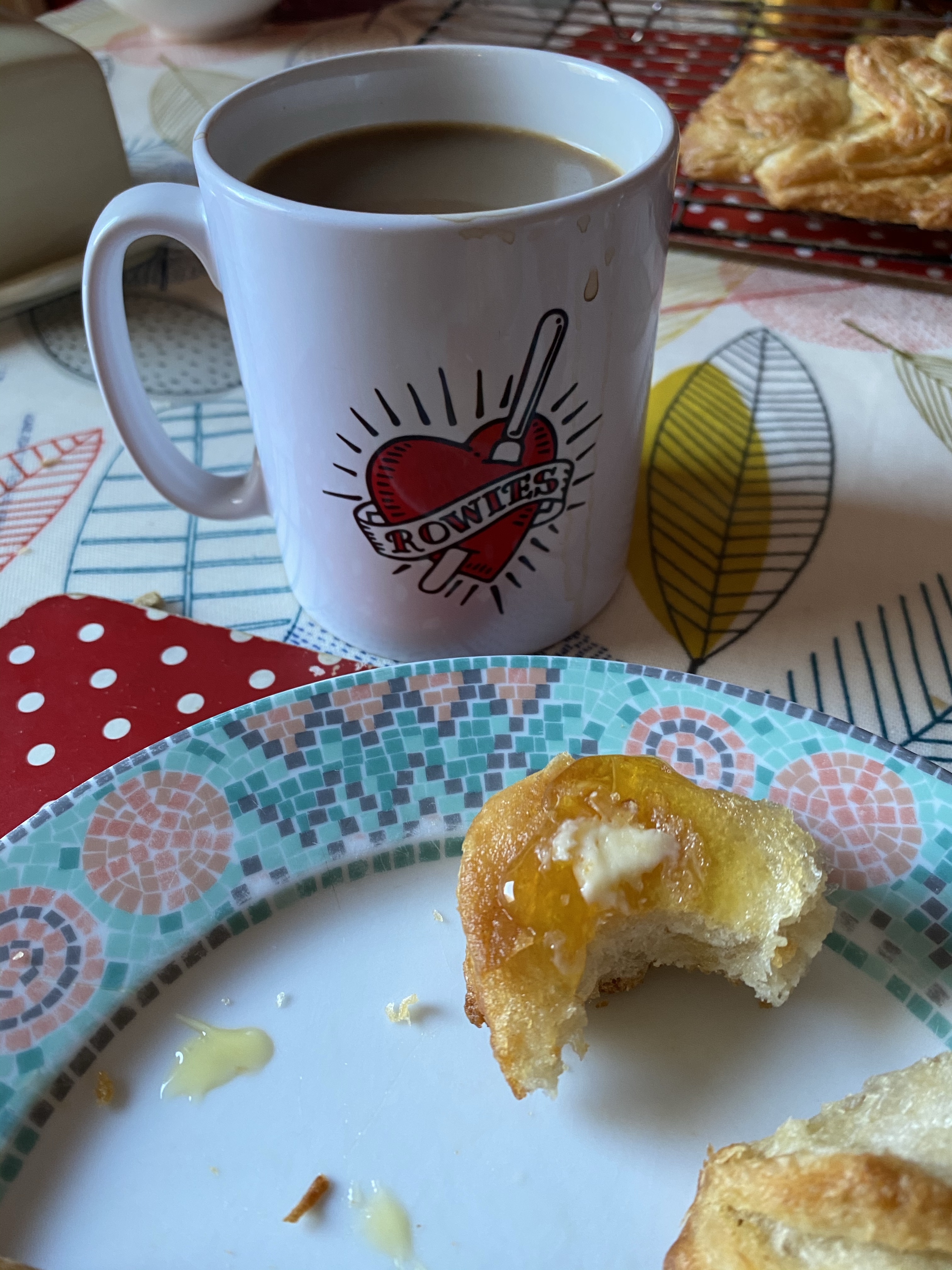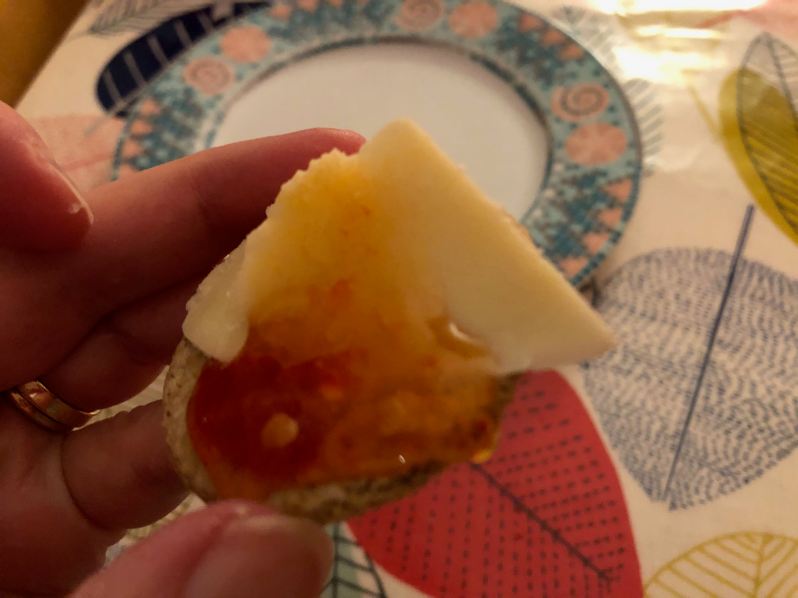
Category: Food

The quest for marmalade perfection
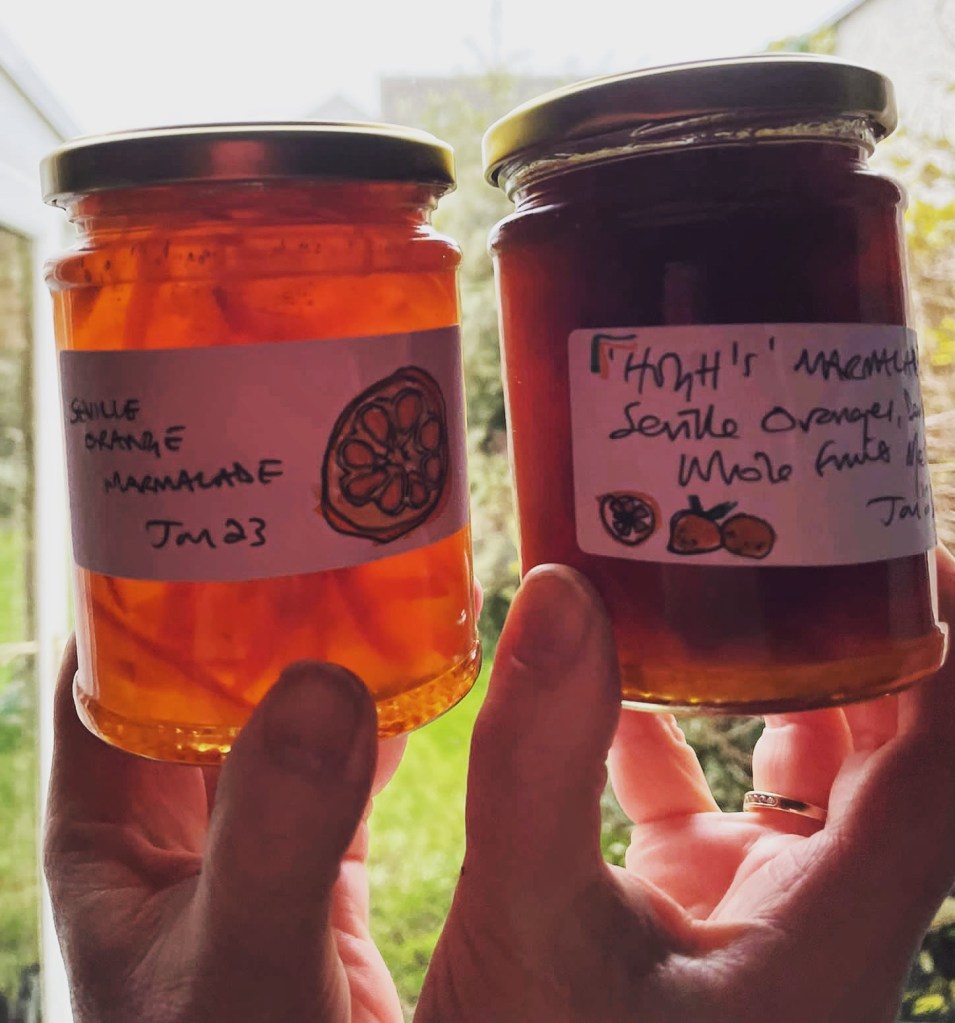
After the sparkle and joy of December, January can be a bit of a drag. Edinburgh is a lovely city but January is still winter and daylight is in short supply. Added to that, my self-imposed New Year quest for health improvement and renewal can, all told, make it a month to endure or thole * rather than relish.

Enter marmalade making and its orange radiance to bring some sunshine.

January is traditionally marmalade month coinciding with the arrival from Spain of the bitter Seville oranges that make the best marmalade. You can make marmalade all year round using tins of pre-prepared fruit, or as I optimistically planned last year, by freezing the time-limited Seville oranges to use at a later date. But it’s the arrival of the fresh fruit from Spain into a grey January that really starts the buzz amongst marmalade aficionados.
When I first started marmalade making a few years back – my attempts could best be described as inconsistent. The end result usually tasted ok but often did not set ( marmalade sauce anyone ? ), and when it did set, the peel all stayed at the top and did not have the desired even peel distribution. So during Covid times, when others were mastering new languages or learning to crochet a blanket, I made it my mission to crack the marmalade code and achieve preserve perfection.
I bought several books on the subject (including unintentionally, one written in French), and a special thermometer to check for a set, and continued making marmalade and other jams with mixed results. Although the taste was usually good – it was hit or miss when it came to setting and achieving the right consistency still proved elusive.
Success only came when I was given some very useful advice from an expert preserves maker, Jaki at Perfectly Preserved. A conversation with Jaki via Instagram helped me to understand where I had been going wrong and she gave me some great advice.

Jaki helped me to understand the importance of watching the shape of the bubbles and how they change as the marmalade reaches the setting point. I would highly recommend following Jaki’s Instagram ( @perfectlypreserved ) for an easy-to-follow ‘how-to’ guide to making marmalade, or if you have no desire to make your own – her delicious marmalade and other tasty preserves including her amazing rhubarb are available to buy online here
Following these top tips, my marmalade started to look better and set nicely, and then later and again via an Instagram chum, I came across a marmalade master class by Vivien Lloyd. Vivien is another marmalade expert, her book First Preserves is an excellent guide with clear step-by-step instructions, and she has been a judge at the World Marmalade Awards so I was hoping for some insider knowledge.
At her zoom masterclass, she demonstrated her fail-safe approach to successfully making marmalade in small batches and was very generous in sharing her expertise, including for me busting the myth and mystery of testing for a set!

Encouraged by my new found confidence in bubble recognition thanks to Jaki, and with Vivien’s top tips front of mind, I made a batch where the set was just right, the peel was evenly distributed AND it tasted delicious.
Encouraged by this – I thought I might enter the World Marmalade Awards and so in January 2022 – I parcelled up my chosen jar and posted it off to Dalemain in Cumbria more in hope than expectation.
Months passed and I had mostly forgotten about the competition- there is a long interval between submitting your entry and getting your result. I had seen lots of pictures of the judging earlier in the year but as I had heard nothing assumed I had been unsuccessful. Wind forward to June 2022 ( 5 months after my submission ) and I was surprised and delighted to receive a certificate in the post with a silver award. Yippee!

Limbering up – marmalade two ways

Encouraged by my success, I am contemplating entering the World Marmalade competition again this year, but feel more nervous – reckoning beginner’s luck won’t be repeated and as is my way – I am now overthinking my marmalade making.
When I was in peak marmalade-making frenzy – and buying up Seville oranges beyond my needs – I froze some of them thinking I would make marmalade in the summer – or maybe a second attempt at making Diana Henry’s Seville orange tart, (a true Labour of love I had made once before with regular oranges). This time I could use the real McCoy.
As it turned out my summer was spent making a wedding cake for my daughter and as our stocks of marmalade were nowhere near depleted, the frozen Seville oranges rattled about in the freezer taking up space until the other day when it occurred to me I could use them to make a test batch of marmalade before attempting my entry for the awards.
By way of limbering up my marmalade-making muscles – and using the aforementioned frozen Seville oranges, I made two different types of marmalade. The first I made following the whole fruit method and demerara sugar ( Hugh’s marmalade recipe from Pam the Jam ) and for the other, I broadly followed my previous year’s award-winning recipe where you juice the fruit, shred the peel, then soak it overnight before cooking the next day and using white cane sugar.



Both marmalades turned out very well but were quite different. The whole fruit recipe using demerara sugar and a thicker cut of peel is darker and has a more robust flavour. I think this is sometimes called Oxford style. In some ways, it is easier to make because the peel is softer to cut when cooked and the flavour is good, but I enjoy the meditative process of juicing fruit and slicing the peel before soaking overnight or longer.
Overall I prefer the marmalade made by the soaking method – it is fresher and has a more lemony taste which is more to my liking and I think it looks prettier.

Using the frozen Seville oranges did not make much difference to the recipe I followed. I read afterwards that freezing can reduce the level of pectin and more fruit or lemon juice should be added to help achieve a set – but I did not change anything.
I noticed that with the frozen fruit – the peel took a bit longer to soften using the whole fruit method and the peel was not as bouncy when I was cutting the peel for those I made using the overnight soak-and the end result was fine.
I don’t think either of these test batches is good enough to enter the competition, but making them was a useful trial run before I attempt my ( fingers crossed ) award-winning entry.

On doing new things

This weekend I made a Tik Tok and drank a Negroni and both of these were firsts for me, or strictly speaking the Negroni was a first time enjoying a properly made Negroni at home – surprised it has taken me so long to embrace this cocktail du jour.
These accidental firsts are not part of an active quest to do new things or me ticking off a bucket list, more a reflection of my butterfly mind and a preference to hop, skip, and jump to the new to avoid doing all the boring old stuff I need to deal with.
Wind back to a couple of weeks ago when the sun was shining in Edinburgh & inspired more by optimism than the reality I bought a couple of cute tins of ready-made Negroni – thinking to enjoy these outdoors as a pre fish supper aperitif. This story has, as many weather dependent stories do in Scotland, a rather muted conclusion when the clouds rolled in from the hills and the appeal of drinking or dining Alfresco evaporated.

Against the plummeting temperatures and grey skies,the tiny cute tin of Negroni was a ray of sunshine- the contents were delicious straight up and made a refreshing long drink with sparkling water added.

So this weekend with research made on the perfect serve ( Stanley Tucci food memoir – Taste My Life Through Food page 9 ) – and ingredients purchased, my husband was appointed barman /mixologist. He created a splendid Negroni even if we had a bit of an exchange of views over some of the finer details around the correct glass to use and whether it was over ice or without.
I am so late to the party on the Negroni front and is odd to have missed out on this joyous experience for so long – what was I thinking? Maybe I missed the cocktail memo or I was washing my hair or just not paying attention. Regardless of the reasons for the oversight I am now happy to raise a glass to this wonderful late discovery. ( and as a note of caution to myself and any new to this delicious cocktail – Negronis are deceptively strong ) 🥴
Cheers !
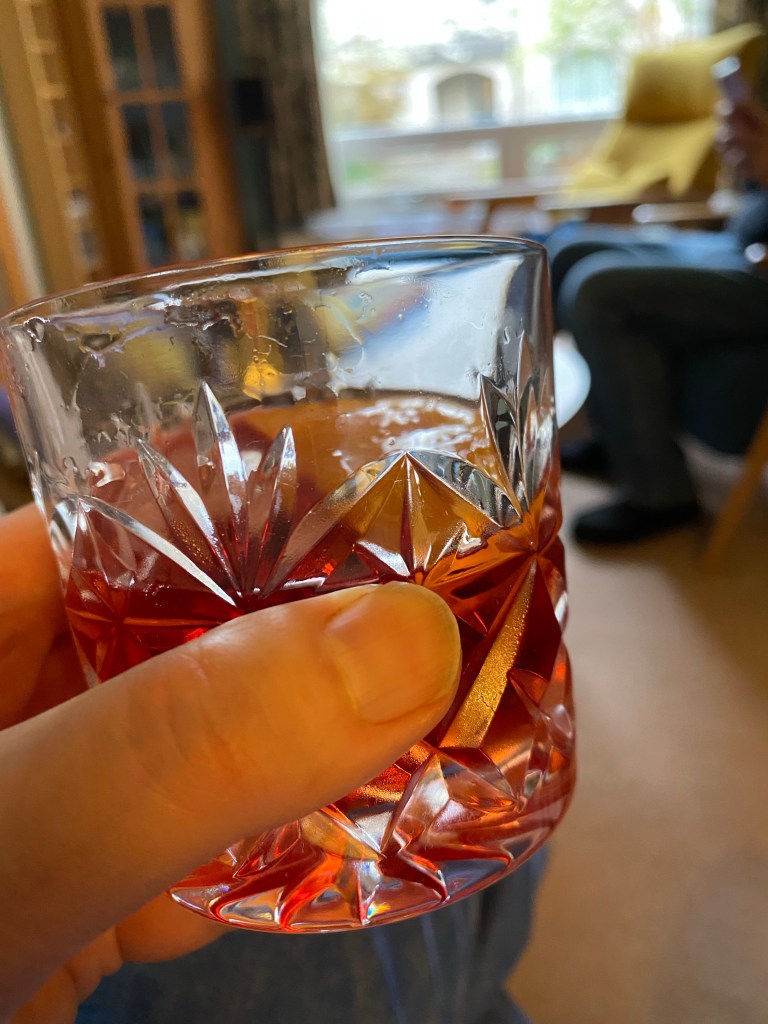
So to the Tik Tok – my daughter was home & so on hand to provide instruction and a steady hand for filming. Dinner was to be lamb with peas, onions and vermouth, a Diana Henry recipe from her book Simple (another first, trying this recipe) and I thought it a good subject for Tik Tok.

Now and again I make amateur recordings of the food I am cooking and post these on Instagram stories. My filming style might be generously described as ‘unpolished’ and the finished output depends on various factors including – how behind schedule I am, how many glasses of wine the cook has enjoyed ( I do channel my inner Keith Floyd ), and whether I am making the recipe for the first time. Readers – do remember to read the recipe all the way through.
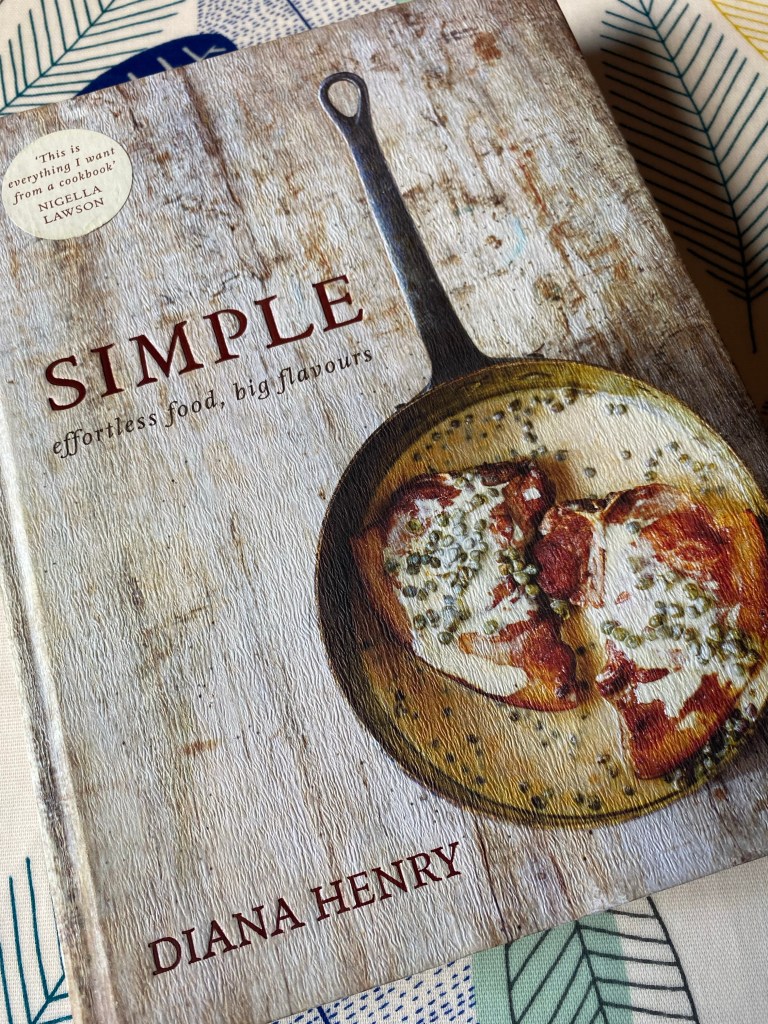
I have no specialist kit to speak of other than my phone and my husband is usually watching football so it’s usually a lone effort,without tripods or flattering lighting. I tend to film in between cooking & often miss lots of steps, and navigating the fine line between verisimilitude and burning dinner is quite the balancing act.
The end result is rarely a ‘how to’ guide, more a cook along and sharing.
My daughter Ellen who is almost a millennial and naturally a digital native, is at ease with phone technology, but more than that she has a really good eye for photography and infinite patience when working with her dear old Mum.
Ellen was both art director and videographer for Tik Tok number 1 – but she did give me small tasks to complete unaided – like choosing the music and cooking the lamb.
For a first attempt using some of the easier Tik Tok functions and effects,I was quite pleased with the finished film and it may have opened up a whole new set of distractions for me from the eternal unfinished ‘to do’ list.
The finished film is here👇
Move over sourdough,there’s a new kid in town.
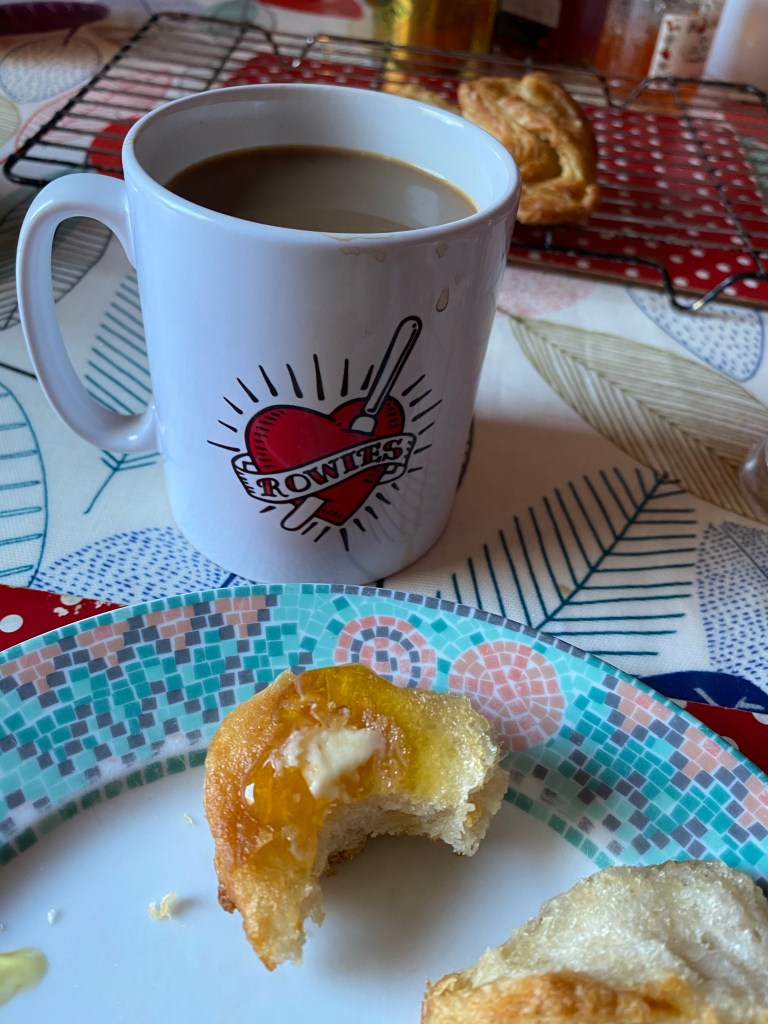
Lockdown has brought out the baker in many of us. In the first, hopeful March lockdown banana bread was the cake of the moment.
Then came sourdough – with many sharing homely snaps of their nurturing starters and stylish crust art.
I am fond of banana bread and did make my favourite recipe a couple of times ( Nigel Slater Kitchen Diaries 2 – dark muscovado & chocolate), but when it comes to sourdough – it’s a big fat NO from me.
I respect those who are evangelical about the yeast free bread’s qualities and I have made sourdough in the past – with varying degrees of success – but I can’t say it was a joyful experience.
The starter palaver and multiple cosseting stages was a bit too ‘needy’ for me 😉and as much fun as following flatpack instructions.
And I have never found that the reward is worth the effort, but I appreciate I may be in the minority with this thinking.
While sourdough perfection is not my thing, I am not immune to a lockdown project and this weekend I decided to try and make Aberdeen rowies .
For those who may not be familiar with the Aberdeen rowie or buttery, it might be unkindly described as a leaden croissant, but not by those of us in thrall to its crispy, fatty, salty loveliness. For those of us who have sampled the aptly named buttery, it is a thing of joy unmatched. They are a sublime taste sensation or as film director Duncan Jones once described them ‘evil bricks of tasty’ .

The rowie / buttery/roll (names vary), has the same flaky, buttery taste of a croissant but with more substance and heft and has a salty flavour . The saltiness means it is delicious served warm with even more butter and golden syrup – or it provides the perfect vehicle for jam or marmalade.
It is a true regional delicacy – and aficionados from the the North East of Scotland whether shire or toon agree it is a baked good of the highest quality and one that is hard to beat. Even if they debate fiercely whether it should be called a buttery, a rowie or a roll.
Whatever name you prefer, the Aberdeen roll gets its golden buttery taste by the addition of generous quantities of fat – the purists say 100% lard – but the recipe I opted for was a 50/50 mix of lard and butter.
To get the flaky texture involves a process similar to that used when making croissants or puff pastry – folding and rolling the fat into the dough several times to achieve lamination.
The fat is distributed and trapped between layers of dough and when heated by some alchemy or magic it creates the flaky texture.
I had read lots of guides on how to do this, and diagrams a plenty, but I only fully understood the method by watching a demo and attempting it with guidance, when I attended a one day bread and croissant making course a few years ago.
Back to my own rowie experiment. I was mostly following a recipe from the newspaper clipping below and testing my weights and measures skills to convert ounces to grams & work out the right ratio of fast acting yeast instead of bakers yeast.I reduced the quantity of yeast from 30 g to 11 g of fast acting yeast.

The recipe is quite straightforward & probably the hardest part is whipping the lard / butter combo to the correct consistency.
The initial dough is made with strong flour, salt, sugar, yeast and water.
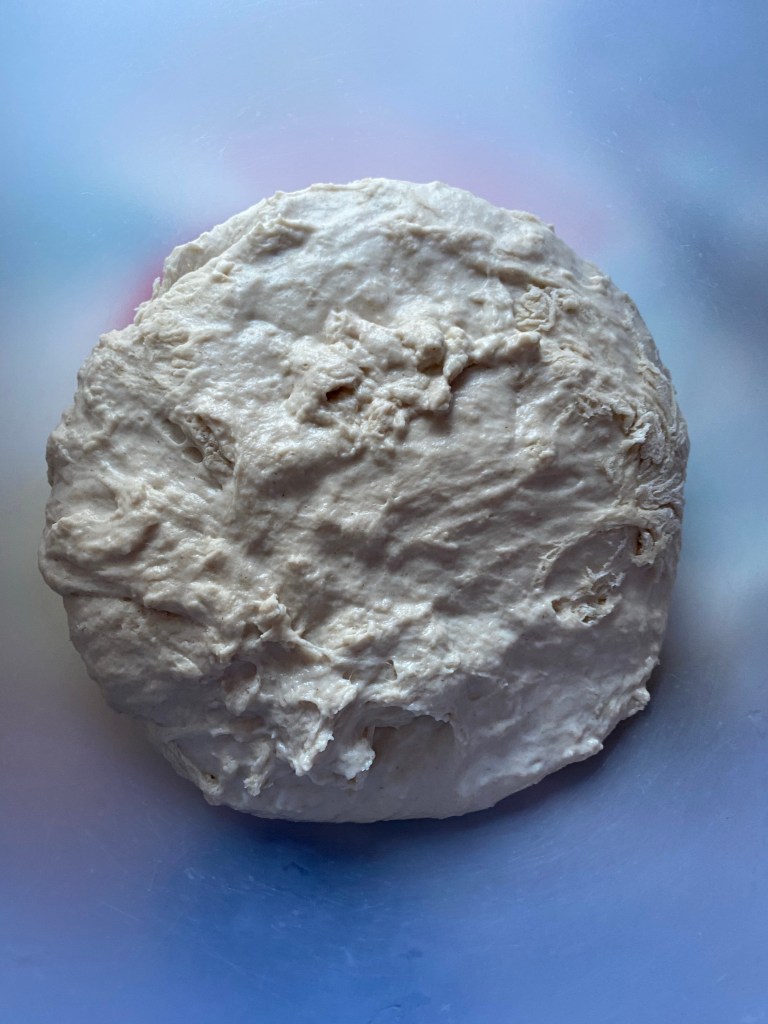
The recipe did not suggest kneading at this first stage but I did give the very sticky dough a short knead before leaving it to prove covered in a bowl with a damp tea towel for about an hour. The dough should double in size.
In the meantime – I creamed the lard and butter together – I did this by hand but reckon it could be done with a food mixer. It has to be creamed up a really soft spreadable consistency.

You then divide the lardy/ buttery mixture into 3 and roll out the risen dough to a rectangle shape 4 inches wide and an inch thick.
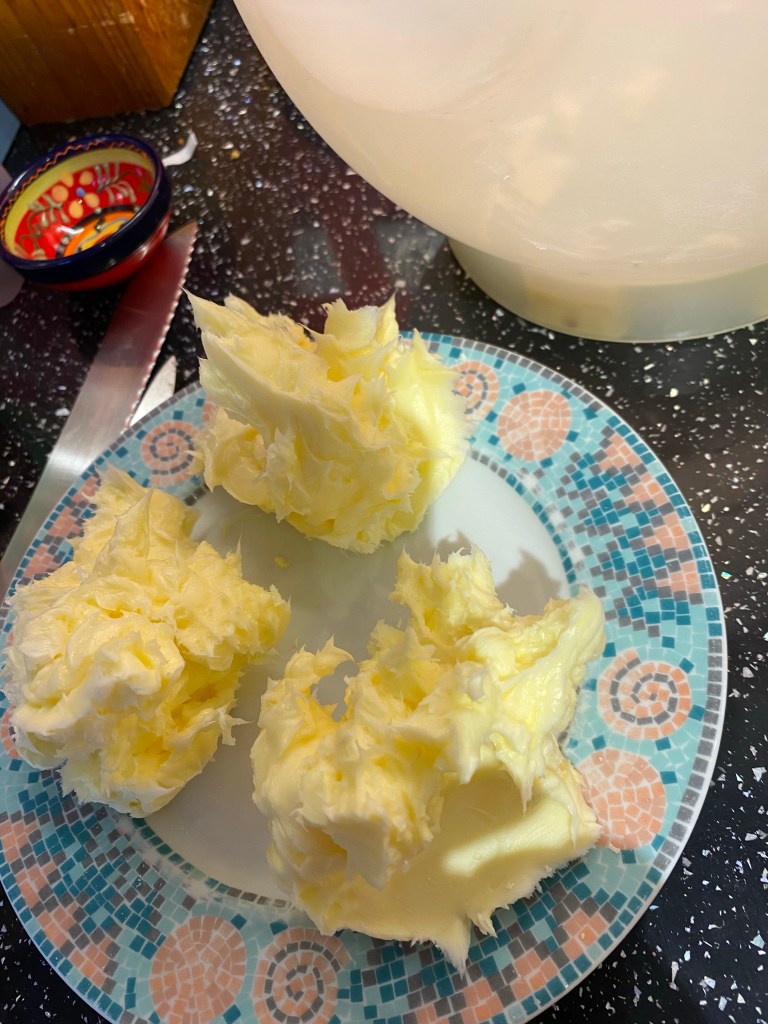
The first third of fat is added – by dabbing small dots of fat to the dough then folded over . I did go a bit free range here because the instructions were to treat as for pastry so I may have rolled and folded more than intended.
You do this process 3 times until all the fat is used up chilling the dough each time.
I put the dough in the fridge for about 10 minutes between each butter and folding session then subsequently discovered in another recipe that this should be 30 minutes, but as is the way with real life – I was doing this while also wanting to do other stuff – ( get out for a walk before dark ) so I did not chill it for 30 minutes.
I then divided the dough into 14 pieces – I cut them and made a token attempt to shape them but they were quite square and not very rowie like. I think this is the bit I would do differently next time.
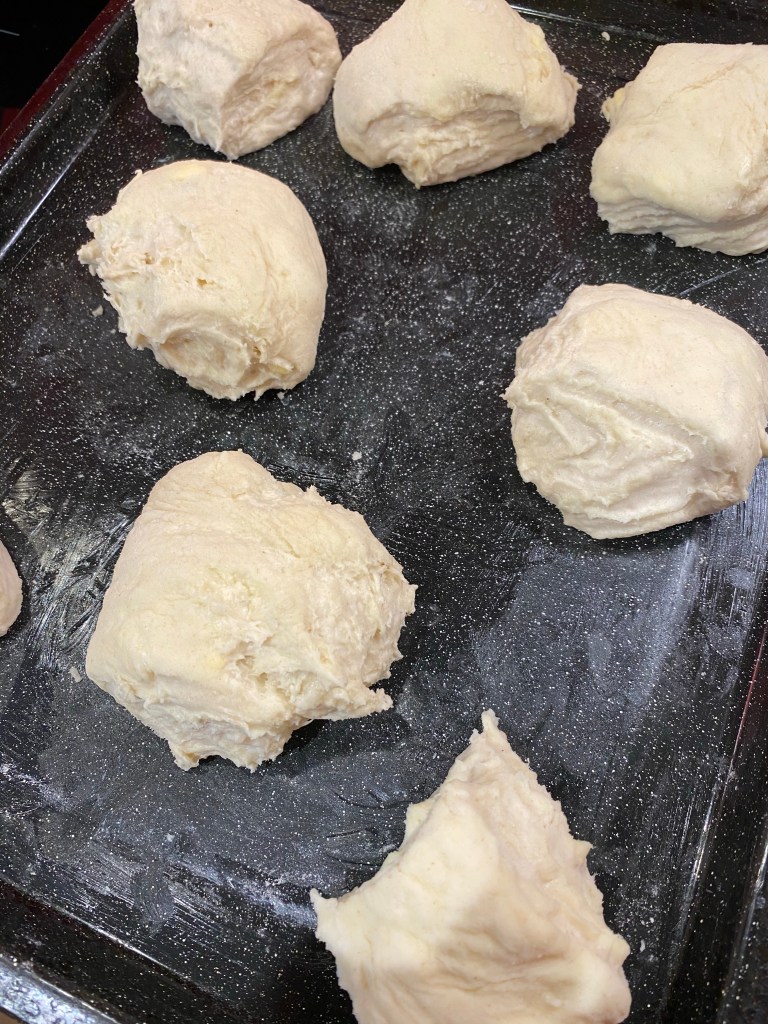
I left the rolls to prove for a further 30 minutes and they do rise a bit more – then I put them into a hot oven ( 200 C ). I added some boiling water to a tray below to create steam – no idea if this makes a difference but in other bread making it can help make a crust.
They take between 20-25 minutes to cook and should be nicely browned. When you take them out, there is what looks like an alarming amount of fat in the tray, so I took them out and let them cool on a wire tray with kitchen roll beneath to absorb the fat.
As a first attempt I was quite pleased although many of them did look more like square edge croissants than Rowies – so maybe I have invented an Auld alliance breakfast delight – the Crowie !
Next time I would tear the dough at the final stage and make them smaller – maybe even flatten them before the final prove. I thought only a few had the distinctive flat fatty brick appearance of a rowie.

The proof of the pudding being in the eating – they tasted like an Aberdeen roll, had a great texture and were both crispy and just salty enough.
My Aberdonian husband pronounced them a success and my mother in law was impressed by my effort so that’s good enough for me.
New year, same me and the search for jam perfection.
January is often the month of new beginnings and great intentions, a time to set a course of action for the next 12 months, to make resolutions, set goals and as December fades into the distance set forth into the new year with gusto.
I do see the start of a new year as a time to review and reflect. I don’t make resolutions as such but I usually think of a few ‘goals’ or things the old me might like to achieve in the next 12 months.
This loose collection of paths to self-improvement might include some new activities to try in the coming year and will always include an optimistic commitment to trying to get better at some of the things I do already.
Practice makes perfect and all that.
Getting back into writing regularly is on my list, having pretty much kicked this blog into the long grass in the past year. I have got out of the habit, and now my writing is reduced to social media posts, work emails, and the odd business report.
Aside from an intention to keep writing, following on from a recent batch of marmalade making – next on my list is a quest to get better at making jam- not with a view to becoming a professional preserver, but more to crack the elusive nut of getting my jam to set.
On paper, making jam and marmalade is an easy process – you combine the right ratio of fruit, sugar and sometimes water, heat it to the temperature of jam setting point then Ta Da! It sounds simple, but while my jams and marmalade usually taste good, they are often very runny and the process of knowing when it has reached setting point is a bit of a mystery.
Some of this is a fear of the pan boiling over – and so to avoid this, I don’t have the temperature high enough – or when it is boiling a fear of letting it boil too long in case it overcooks,( having once made blackberry jam that was like industrial strength glue).
Recipe books offer instructions and guidance, but rarely give much detail around timings. I suppose it is because as with most cooking, there are unknown variables relating to your own kitchen and equipment so success comes through trial and error and accumulated knowledge.
Apparently, there is a magical knack of knowing when the bubbles in the pan have changed – and recognising this I imagine only comes with practice.
As I only tend to make jam or marmalade once or twice a year – reading the jam bubble runes is a skill not yet mastered. This year I had to reboil marmalade when after cooling it still looked more like orange soup than a breakfast conserve. So after that near disaster, I bought myself a jam pan and a thermometer.
Today I gave my new pan and thermometer combo a test drive – making scarlet chilli and red pepper jam, a recipe from Diana Henry’s book Salt, Sugar Smoke. Intrigued by the prospect of making the evocatively named scarlet jam, I set forth on a new path in my preserving journey – as I have never made jam with peppers or attempted any kind of savoury relish before.
It was an easy recipe to follow, with only a few ingredients and it looked beautiful bubbling in the pan as the peppers and chilli transformed from raw ingredients to jam.
As always it took longer than I expected for it to reach setting point, but this time I persevered, even letting it rise above the mystical 104.5 C. Using both my thermometer and the wrinkle test as guidance I studied the bubbles, stared into the glossy pot and followed my instinct 😉
I don’t imagine I will ever win any jam making contests – but it tastes good and looks like it will set.
Bravo to me !
Accidental Edinburgh Fringe ‘Greek’ yogurt
Last week I took a notion to make yogurt.
I was prompted in part by reading Tom Hunt’s Waste not column in Feast in the Saturday Guardian.

Each week in the Feast food supplement, Tom Hunt highlights various ways to reduce waste in the kitchen focusing on a different ingredient each week. This week it was chillies.
To make the most of chilli waste, you can save discarded seeds and dry them to season other dishes, and in something of a revelation to me, it turns out that the green stalks of chillies contain the beneficial bacteria lactobacillus and can be used instead of a starter to make yogurt.

I had chillies that I was using to make Menemen ( Turkish egg dish) for brunch and lots of milk – so was looking forward to trying out this eco tip.
So far so good – except I had not read to the end of the recipe – where I noticed it asks for 10-15 chilli stalks.
While I do like my Turkish style eggs spicy – 10 chillies is a bit too spicy !
Having decided to make yogurt I did a quick trawl of the internet for yogurt recipes – more by way of a reminder of quantities, as I have made yogurt in the past.
In my teenage years, I went through a phase of making soft cheese ( crowdie) and yogurt. I would like to say I was ahead of the artisan foodie curve but probably closer to the truth is that I lived on a farm in a small Highland village & was just a bit of an oddball.
Making yogurt is not complicated – and sometimes can happen by accident as I found out when I left a carton of milk on the windowsill of a Premier Inn hotel room on a business trip a while back. Reader – I ate it.

So back to my yogurt making – having gleaned the essential facts from the internet and reminded myself of the steps and quantities – this is what I did.
1. Gently heated up a pint of full-fat milk.
2. Left milk to cool to the temperature of a hot bath ( 45 degrees C )
3. I then took a couple of tablespoonfuls of Greek yogurt – from an existing tub, to use as the starter.
4. To warm the starter, I mixed a couple of tablespoons of the warmed milk into the Greek yogurt to make it runny and less cold before adding it back into the rest of the warmed milk.
5. I used my slow cooker to heat up the stoneware container so that the mixture went into something warm. If you don’t have a slow cooker – the important thing is to put the mixture into something that can retain heat – a thermos or just a sealed container than will keep the temperature even.
6. Having warmed the container – I put the yogurt ( that I had warmed a bit) into the warm milk then put the starter + milk mixture into the warmed slow cooker pot.
7. I switched the slow cooker off and took the stoneware container up to a warm room where I covered it in a thick blanket and left it for a few hours.
About 5 hours later it was well on the way to becoming yogurt but I decided to leave it overnight.
The next morning TA DA !
Yogurt
It tasted ok – quite mild, but I thought it was a bit runny and as I eat a lot of Greek yogurt I thought I would try straining it to see how it turned out.
I put the yogurt into a muslin lined sieve over a bowl and left it to drip in its own time.

I was heading out to a show at the Edinburgh book festival so I just left it dripping.

We ended up staying out later than planned and going to some more stuff at the Fringe so the yogurt had been doing its dripping thing for about 9 hours by the time we got back.
The result was a small ball of thick yogurt – maybe closer to fromage blanc than Greek yogurt in texture – but with a lovely mild flavour.
As I don’t have any pigs I drank the leftover whey – the strained liquid. No idea if it’s good for you but it was a refreshing slightly tart drink.
To make the yogurt a bit creamier I added back in a couple of spoons of full fat milk and the end result was quite close to the shop bought varieties.


It’s a fairly easy thing to do. I don’t think it gives any better result than buying a tub, but it’s quite satisfying making your own.
I might experiment with different types of milk ( e.g. Jersey or unhomogenised ) and also the length of time I strain it to see if that makes a difference to the end result.
Meanwhile, I have started saving my chilli tops in the freezer ( which I hope does not destroy the lactobacillus) and when I reach 15 I will give the chilli yogurt a whirl.
Christmas cake baking – and running of course. Day 3
 Today I decided to bake a Christmas cake. I used to get a bit hung up about baking the Christmas cake on a set day in November, but I decided it does not make any difference to the flavour so I just bake it a few weeks before Christmas whenever I can find some spare hours.
Today I decided to bake a Christmas cake. I used to get a bit hung up about baking the Christmas cake on a set day in November, but I decided it does not make any difference to the flavour so I just bake it a few weeks before Christmas whenever I can find some spare hours.
Making the cake is pretty straightforward – especially since I have started using a recipe recommended to me by my friend Sally at fitnaturally. Sally got this recipe from her neighbour and friend – Mrs Williams – sadly no longer around – and it is both the easiest and nicest Christmas cake recipe I have tried. I also like the thought of Mrs Williams skills in baking being shared far and wide, and enduring. That’s the lovely thing about baking and passing on recipes.
So Mrs Williams Christmas cake recipe is kind of an ‘all in one’ method – where you put the fruit, sugar, butter and spices into a pot then heat them up.
Then you add all the other ingredients to the cooled fruit mixture, give it a good mix and that’s it!
I find the hardest part of baking a Christmas cake is lining the tin, and with the long slow cooking, it is important to line it properly. But though it is a fiddly job – it is an enjoyable ritual of sorts – wrapping the cake in its jacket of brown paper and string. And there is something very comforting about the gathering of ingredients, the preparation and then the aroma of Christmas cake baking that gets me in the festive mood.
Before baking the cake – I went on my day 3 run with Alison. Today we went on another of our weekend routes where we run from Colinton to Stockbridge. It is around 6 miles and pretty much downhill all the way following the water of Leith – so lots of running through woodland. We then get the bus or a lift back, so it’s an easy 6 miles.

We could run there and back and many runners would do this by way of a longer Sunday run, but I am not training for any race at the moment and one thing I have realised over the years of doing run streaks- is that there is no point adding in extra mileage if you don’t have to.

As it was, we had a very enjoyable social run rounded up nicely by a breakfast of fried egg roll and coffee at the Water of Leith bistro.

Day 3: 6.01 miles
December total : 14.32 miles
Weather : fresh and sunny 4 degrees
writing and running in the key of green

Running in the months of January, February and quite a bit of March – the skies have been grey, the trees bare and the paths muddy brown.
But this weekend the sun came out and as if by magic everywhere was green.
Wild garlic seemed to grow overnight into a lush fresh carpet of pungent loveliness and even my neglected garden threw up some vibrant colour – bless my everlasting die hard euphorbias.

With Monday a rest day from running, I picked some of the wild garlic and made pesto.
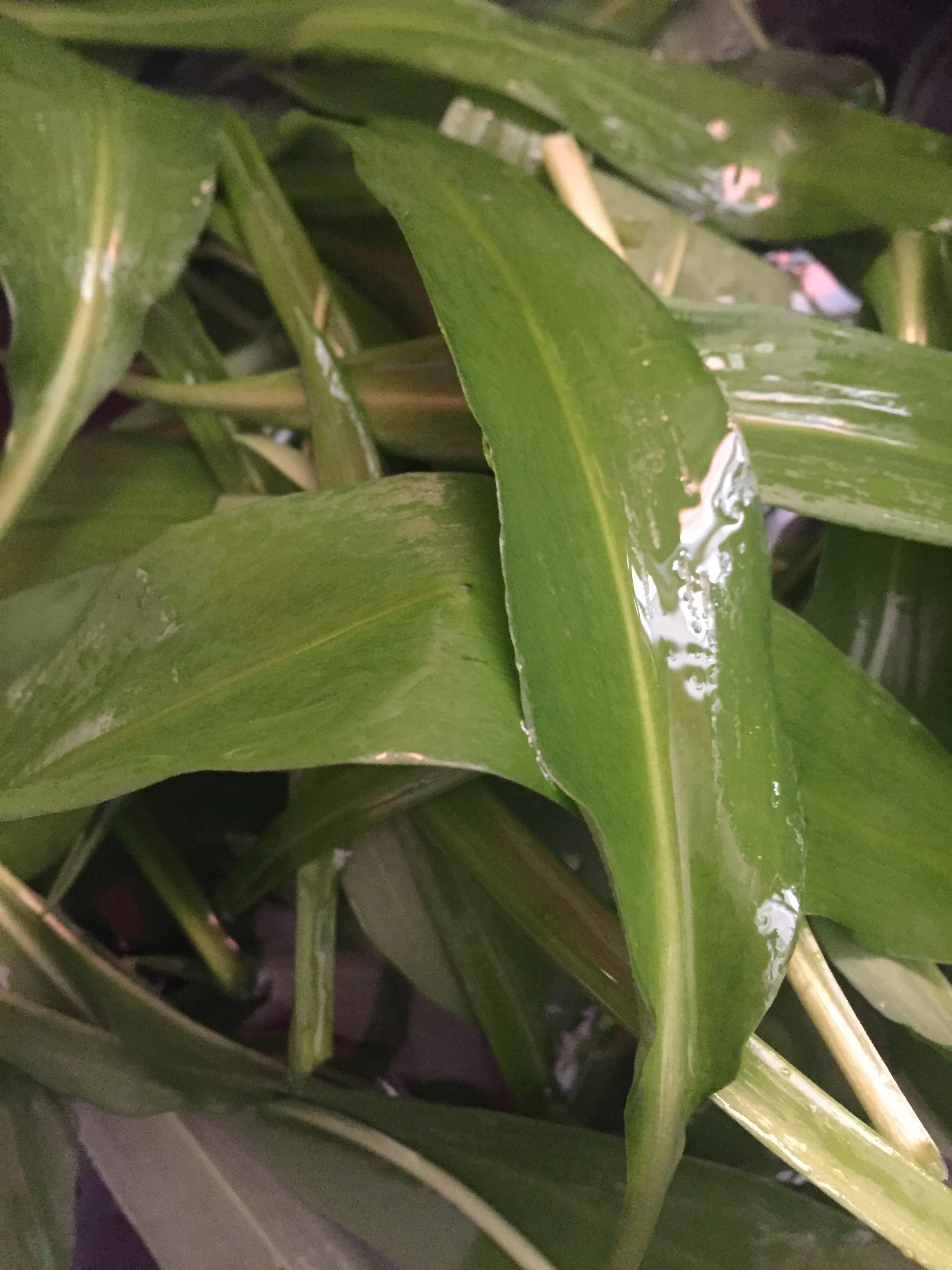
Food for free ramsons reminisences
Earlier this month I made wild garlic pesto with my daughter and thought it a very current thing to do. Foraging,making food from scratch and connecting with nature definitely seems in vogue right now.
The day before we had taken a walk to collect the wild garlic from a woodland path and then, with a 21st century twist to our attempts at wild survival,had Googled to verify the plant type lest we pick anything deadly and then referred to Google once more to find a recipe.
Was very enjoyable to first harvest the leaves, then make the pesto together – even if the pine nuts, pecorino and olive oil were neither free nor foraged locally. But satisfying still to make food with a tiny connection to the land and to enjoy a bit of mother – daughter bonding over a shared food discovery at the same time.
After our pesto adventure I came across my ageing copy of Richard Mabey’s book -Food For Free – given to me as a school prize for Modern Studies in 1976. Prize winners were free to pick their own book and my choice of this guide to feeding yourself from nature’s larder was, I imagine, something that fitted with me going through something of a mildly hippy phase – along with dressing in cheesecloth and listening to Bob Dylan.
In the mid 70s at the school I attended my favourite teachers seemed to me very modern and liberal – certainly after my village primary school. My teacher of Modern Studies,with her views on the Russian revolution and questionable power of the media certainly appeared to be interesting, worldly and cool to my 14-year-old self.
Choosing the Richard Mabey book coincided with a rather fogeyish interest I had at the time around the disappearing skills of food preservation and cooking and wanting to know more about how things were done in the ‘olden days’ – quizzing my farmer dad about how to preserve food, make butter and making a reasonably successful attempt at crowdie – basic cheese making.
With the benefit of hindsight I could say this was me reacting to the change I saw in eating patterns and dominance of factory produced ready meals – Vesta curry, Findus crispy pancakes and the like, but I don’t know that I was trying to make a social comment or that I was ahead of the curve, more likely I was just a bit of an odd child.
Is interesting now as with a renewed interest in food provenance and craft skills more prevalent to think of that curiosity and my childhood experience. Many things I took for granted growing up in the countryside around freshly grown food and a kinder approach to farming now seem to pop up on lifestyle and food programmes, magazine articles as a return to a better way to live and eat. Reassuring I suppose to know that while food trends and fashion ebb and flow the fundamentals of good taste, heathy food and craft survive.
These days I no longer live in the countryside so my foraging is of the urban variety and I am really just a dabbler in trying to find food for free, but through the small act of gathering wild garlic and making pesto with my daughter, I felt I had gone some way to rekindle my latent hunter gatherer.


